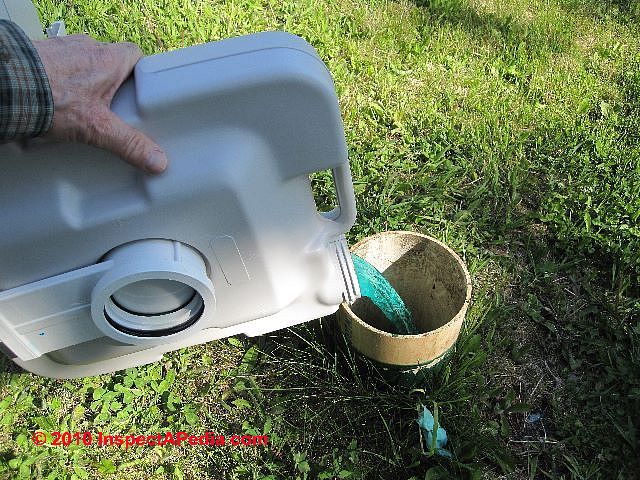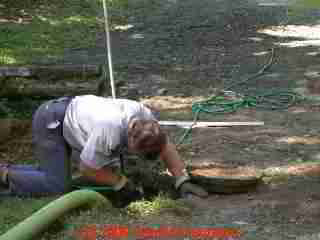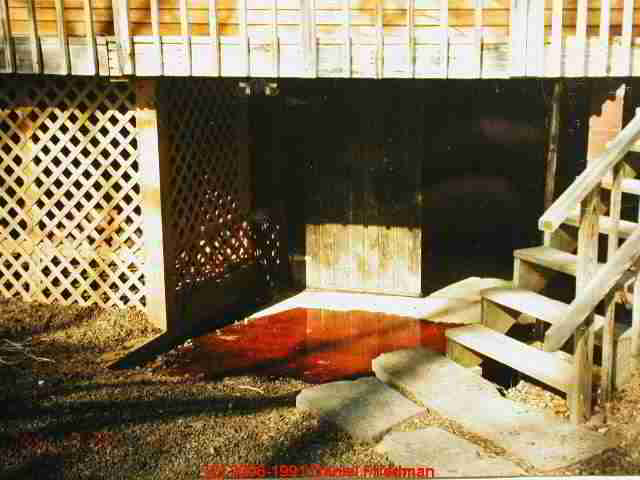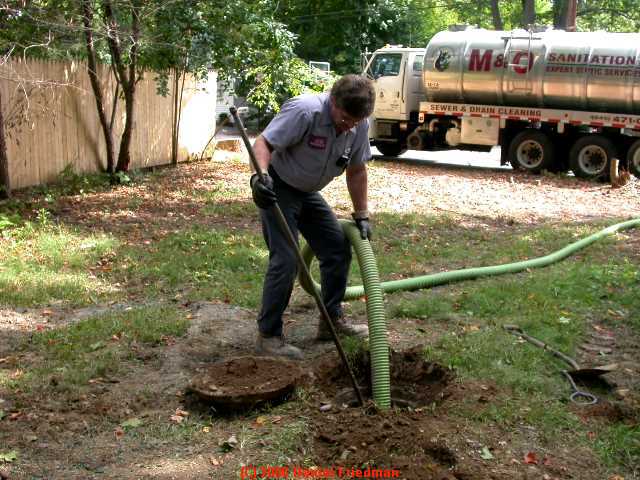 Septic Tank Cleaning
Septic Tank Cleaning
Pumping Mistakes to Avoid
- POST a QUESTION or COMMENT about mistakes an misconceptions about septic tank pumping and cleaning requirements
Septic tank pumpout SNAFUS:
This article describes common mistakes and misunderstandings about cleaning or pumping the septic tank.
We explain why pumping too infrequently (or never) is a bad idea but we add that pumping more often than necessary is more or less tossing money down the toilet.
We also explain why a septic tank is normally always "full" and that after pumping the septic fills up pretty quickly in normal use. The article also describes effective vs. ineffective septic tank pumping and how you can improve the septic tank cleaning procedure so that pumping the tank is actually useful.
Finally we note immediate & serious safety hazards that should be addressed when cleaning septic systems.
InspectAPedia tolerates no conflicts of interest. We have no relationship with advertisers, products, or services discussed at this website.
- Daniel Friedman, Publisher/Editor/Author - See WHO ARE WE?
Avoiding these Septic Pumping Mistakes
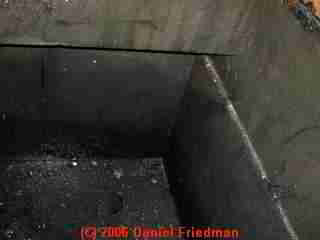 Four septic tank pumping schedule mistakes
Four septic tank pumping schedule mistakes
- Failure to pump the septic tank frequently enough:
leading to an early drainfield failure and to the need for costly repairs - Pumping or cleaning the septic tank too frequently,
wasting money (though you're wasting a lot less money than the cost of a new drainfield.
Some septic pumping contractors and some other "experts" give a fixed rule of thumb that gives advice that is safe and profitable such as "pump your septic tank every year" or "pump your septic tank every two years".
This advice is safe but except for unusual circumstances it is wrong.
Contractors may give this advice without first having actually considered any information about the actual septic system capacity, size, level of usage, age, or other conditions.
The OPM Problem:
It's a great example of "OPM" or "other people's money" - spending someone else's money to reduce your risk that they'll complain that your advice wasn't safe enough.
In a failing septic system case in Minnesota, the contractor assured that "things will be fine if you just pump the septic tank every couple of months or after you've had a lot of visitors". The theory is that you pump the septic tank the septic tank after heavy usage to "get back to normal".
It might be smarter to pump the septic tank before or both before and after heavy use when we know a septic system is marginal. But this can be pretty expensive.
Using a hired port-a-john might be much less expensive and might help avoid a sewage backup.
See SEPTIC BACKUP PREVENTION for tips to avoid a septic problem during times of anticipated heavy septic system usage. - Pumping the septic tank to "fix" a clogged or failing drainfield.
All you really gain is a few days of toilet flushing before the tank has re-filled, or at most weeks of respite.
More frequent pumping of the septic tank amounts to treating the septic system (tank and disposal fields) as a septic holding tank system instead - a costly proposition that may be necessary in some emergencies but not an attractive solution to onsite wastewater disposal.
More about this snafu is provided below. - Pumping the septic tank before a septic system inspection or test.
the purpose of this tank pump-out is to hopefully prevent the inspector from finding evidence of a failed drainfield. An empty septic tank prevents the test-inspector from pushing any effluent into the drainfield.
See WHEN NOT TO PUMP A SEPTIC TANK.
Ten Septic Tank Fantasies - costly misconceptions worth reconsidering
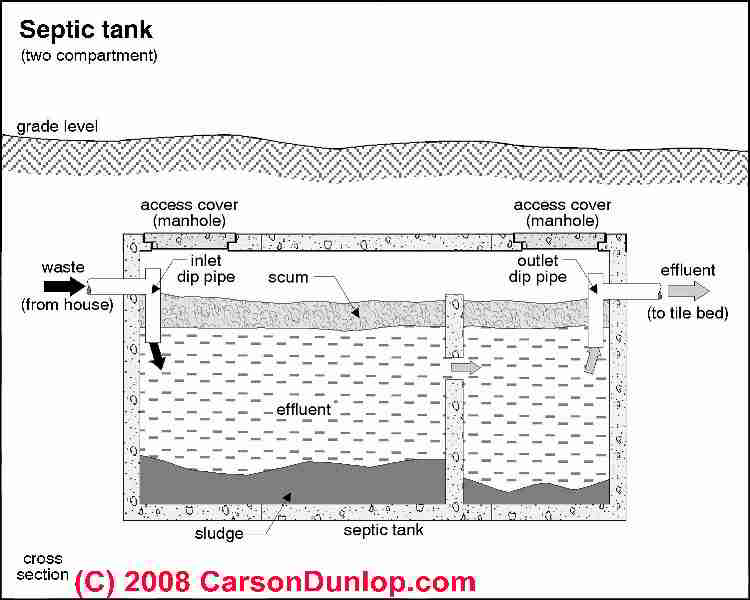 If you're normal you don't have fantasies about septic tanks. OK let's call these "septic tank misconceptions" that are worth clearing-up both to save money and to care for the system effectively.
If you're normal you don't have fantasies about septic tanks. OK let's call these "septic tank misconceptions" that are worth clearing-up both to save money and to care for the system effectively.
[Click to enlarge any image]
Septic tank fantasy No. 1: we need to pump out the septic tank whenever the septic tank gets full
Wrong.
A septic tank in normal use is always full, right up to the bottom of the outlet pipe (near the top of the tank).
After pumping it out completely, an empty septic tank fills up again under normal usage in just a few days, after which it is again discharging liquid effluent to the absorption field, soakaway bed or leach field - names vary by country.
In a normally-working conventional septic tank we find wastewater, or "blackwater": a combination of watery sewage effluent, a floating scum layer at the tank top (in Australia the "scum blanket", and settled sludge in the bottom of the tank.
If as in the sketch above we could see a cross section of the septic tank contents (if we wanted to) we would know when pumping the septic tank is actually necessary based on its sludge and scum layers - that is, based on data instead of either theory or wild arm-waving.
A septic pump-out is needed when the thickness of the floating scum layer and settled sludge layer occupy so much of the tank volume that the free liquid area is "too small" - the "net free area" has become so small that
t
he EFFLUENT RETENTION TIME,
the time that wastewater has in the tank to allow for solids and floating scum to separate from effluent being discharged to the drainfield (soakaway in the U.K.) is too short. This gives new meaning to time is short, right?
Short septic tank effluent retention time means we're pushing solids into the drainfield, clogging it up & shortening its remaining life.
Two valid septic tank cleaning approaches involve either using
the SEPTIC TANK PUMPING SCHEDULE or using objective data obtained by actually inspecting the septic system, diagnosing any problems or failures, and inspecting conditions inside the septic tank.
In part II of this discussion
SEPTIC TANK OBJECTIVE DATA we explain how a septic contractor can measure the scum and sludge layers.
That's a step that's sometimes worth the trouble and that might be taken the next time you have the septic tank pumped.
You can't see into the septic tank, but a contractor, by opening the tank
can MEASURE SEPTIC TANK SCUM & SLUDGE.
Pump the septic tank when ANY of the following is TRUE
- Total depth of scum plus sludge layers equals 1/3 of the depth of the tank
- Bottom of the septic tank outlet baffle has less than 3 inches of clearance from the bottom of the floating scum layer
- Bottom of the outlet baffle is less than 6 inches from the top of the sludge layer on the septic tank bottom
If you're are among the two percenters who want to become expert on this see or
see SEPTIC TANK LEVELS of SEWAGE.
Finally, sometimes extra septic tank pump-outs are useful - something that we will discuss below.
Septic tank fantasy No 2: additives and chemicals will fix or extend the life of the septic system
Nope.
In a conventional and most other septic system designs not only do additives, chemicals and treatments do little or no good, some can damage the system, causing frothing, causing solids to be discharged to the drainfield.
No expert recommends the use of septic treatments or additives, and these substances are illegal to use in many jurisdictions in the U.S. and Canada, at least in part because some of them are also toxic and are environmental contaminants.
Details are at CHEMICALS & TREATMENTS for SEPTICS.
Septic tank fantasy No 3: some septic systems never need to be cleaned, pumped, serviced.
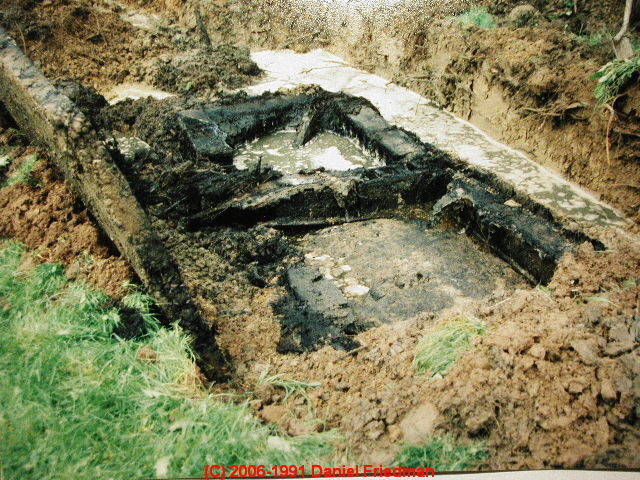
Nope. As my Mom used to day, in your dreams, buster.
The septic tank shown at left was totally packed with solids and was collapsing - it had not been pumped in decades. The home, occupied by a single elderly person, limped along until new owners bought the property and tried taking a couple of showers.
The morning after the new family moved in sewage was coming up in the yard. This case is discussed
It is true that the required septic cleanout frequency varies not only by tank size, wastewater volume being produced, and system design, and some systems require less frequent cleaning for the same usage level compared to other designs, but all septic systems need periodic maintenance.
Failure to properly maintain the septic system is the No. 1 cause of early septic system failures.
Septic tank fantasy No. 4: pumping out the septic tank can restore or save a failed or failing drainfield
Unfortunately, a drainfield or soakaway bed that is in failure would require an estimated 5-10 years of total rest to "recover" enough to be restored to normal use.
Even then the field won't work if it's flooded or if the field has been damaged by vehicle traffic, tree roots or similar troubles.
What you actually get by extra septic tank pump outs in an area of failed drainfield is a few days (less than a month) of toilet flushing and wastewater disposal into the septic tank until it fills up again and is again trying desperately to push septic wastewater effluent out into the soakaway bed.
How quickly does the septic tank fill up again? Experts estimate as much as 200 gallons of wastewater is generated per occupant per day
Even using a fantastically small number of 50 gallons per person per day in a home where extreme water conservation measures are in effect or where there is a single elderly occupant using very little water, the septic tank still fills up quickly - typically in as few as 1-2 days, or at most in about 20 days of use.
Resting a failing or failed drainfield for 20 days doesn't fix anything.
Septic tank fantasy No. 5: all we need to do is pump the liquid out of the septic tank
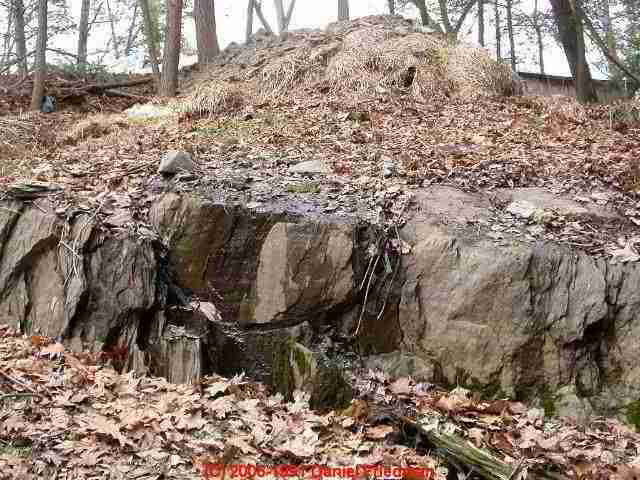
Wow what a mistake this is.
In my photo above I show sewage effluent running down a hill over rock.
That straw-covered pile in the top of the photo was covering the septic tank that the property seller had asked her septic contractor to pump out just a few days before my inspection.
That the system was in total failure was evident after just two days of household use of the septic system.
The tank had re-filled in that time, then sent effluent to the property surface.
To be of any use at all, when pumping the septic tank we need to remove the settled sludge and floating scum from the septic tank, not just the liquid effluent.
If the septic contractor just pokes that septic tank pumping hose down into the middle of the tank and just pumps like mad all she's doing is removing the effluent.
The sludge stays on the tank bottom - or most of it does - and the floating scum falls down to rest nicely atop the sludge layer.
 What is our septic tank pumping contractor doing with that pole in his right hand while he manipulates the pumper truck hose with his left?
What is our septic tank pumping contractor doing with that pole in his right hand while he manipulates the pumper truck hose with his left?
He's using long-handle hoe-like tool to scrape and stir up the dense sludge on the septic tank bottom, mixing in a bit of liquid so that the vacuum hose can pull the sludge out of the septic tank.
Your guy doesn't do this? Interesting.
Watch out: If your septic tank pumping company tells you it's a good idea to leave solids in the septic tank - we know of a company that actually returns solids to the septic tank after separating out the effluent in their special pumper truck
- Just Say NO! Tell 'em not to let the door hit their backside while they're on the way out.
You need to find a different septic pumping service.
The We Pump it & then We Put it Back septic pumping company is simply saving themselves the cost of disposing of sewage from their truck, they're not doing anything to help your septic tank nor system and they're speeding the demise of the absorption field.
The object of tank pumping is to remove the solids (sludge and scum) from the septic tank and thus to increase
An effective septic tank cleanout removes the scum and sludge by moving the pumping hose around and by using the liquid effluent to help break up and pump out the solids.
If the pumper just tackles the easy task of pumping out the liquid effluent itself he's not performing a useful job.
Just pumping out liquid effluent doesn't benefit the system. In fact, just pumping out effluent and leaving the solids means that after every such unfortunate "mis-service" of the tank the actual remaining tank volume available for wastewater treatment is less and less.
Septic tank fantasy No. 6: it's possible to pump the septic tank through a small-diameter pipe or riser
Not easily, but it might be possible. In traditional septic tank cleaning operations the operator needs room to manipulate the septic pumper truck hose to remove the floating scum layer and settled sludge layer.
Without manipulation space and room to stir sludge and scum with a hoe, rake or other tool, removal of solids is difficult and might be limited.
At left we show small-diameter septic tank riser that has been used for years to "pump out" the septic tank at this Minnesota home.
I'm using this mini-septic-tank-riser to empty a small chemical toilet - which is OK as long as we respect the guidelines
at RV HOLDING TANK DUMP INTO SEPTIC TANK?.
But how thoroughly do you think the septic tank pumper can clean the septic tank working through just this small-diameter opening to reach a tank located several feet below?
Using a Manual Tool to Break Up Septic Tank Sludge & Scum for Pumping
Unless we do something extra (see below) it is just about impossible to remove most of these key constituents if all we can do is poke a pumper hose straight down into the septic tank.
Jimmy Herring (Herring Sanitation, Poughkeepsie, NY) demonstrated the right way to clean out a septic tank in the photos below. You'll see that Mr. Herring is working through a much larger opening - the septic tank access cover gives enough room to manipulate the pumping hose.
Crust-Busters to the Rescue!
Crust Busters provides a motor-driven auger that stirs up the septic tank floating scum and settled scum layers, permitting the septic tank pumper to successfully remove these constituents along with septic effluent.
The Crust Buster is a 33-pound motor driven mixing device that combines an 80-inch shaft with folding, hinged mixing blades that open out when spinning to break up and make septic tank solids pump-able through a small access port.
Depending on the diameter of the septic tank pumping opening the operator selects a 2-blade attachment that can slip through a 4-inch diameter opening, or a 3-blade attachment that is not collapsible and fits through a 12" or larger diameter opening. Crust Buster shaft extensions permit operating the device in deeper septic tanks. - Thanks to septic cleaning contractor Daniel Zeimet, Two Harbors MN, for this tip.
- Crust Busters 13667 Meridian Avenue North Monticello, MN, 55367 Phone: 1-888-878-2296 Phone: 1-763-878-2296 Fax: 1-763-878-2299 E-mail: sales@crustbusters.com, website: http://www.crustbusters.com
- Daniel J. Zeimet, DBA Lind's Septic Service, 1932 Big rock Road, Two Harbors, MN 55616, Tel: 218-834-6969
You could also fabricate your own septic tank sludge/scum break-up tool or scum and sludge measuring tool.
See TOOLS for MEASURING SCUM & SLUDGE.
Still Septic Tank Inspection Limitations May Remain
Still, working through a tall, narrow 6" diameter vertical riser, it is difficult if not impossible to inspect the septic tank condition and that of its baffles through such a narrow vertical access opening, even using a traditional flashlight and mirror.
See INSPECT the SEPTIC TANK DURING PUMPING
If we can't gain visual access to the septic tank interior or visual access by removing covers at the inlet and outlet ports, we won't know the condition of the tank, it baffles, its sludge and scum layers.
We also may not know if there are leaks into the septic tank or leaks out of it through damage or poor seals at any of its openings.
Without using a larger septic tank access opening we probably won't know if a flooded drainfield is back-flowing into the tank during pumping, and we won't know how much sludge and scum were left in the tank.
The photos above and show important conditions in the septic tank that you cannot possibly see through an 8" diameter septic tank riser.
Technical note: it's possible to add a large-diameter septic tank riser capped by a vehicle and child-safe cover to make future septic tank servicing more effective. But don't spend on this improvement before knowing that the septic tank itself will continue in use.
For example, a rusted-out steel septic tank is going to need complete replacement.
It may also be possible to gain improved visual access to an otherwise difficult-to-access septic tank interior using electronic gear including flexible borescopes, lights, and similar remote inspection camera-equipment: all added sophistication, complexity, and costs that may mean these tools are not in the hands of most septic tank pumping companies.
Septic tank fantasy No. 7: it's ok to discharge excess septic effluent from the septic tank to the surface, to a nearby drainage ditch, lake, stream, or to your neighbor's yard.
Are you kidding me?
In a conventional septic system (tank and soil absorption bed or drainfield) no more than 40% of the wastewater treatment is handled by bacteria in the septic tank. The rest of the wastewater treatment occurs thanks to bacteria in the soil.
Discharging such wastewater anywhere out of the treatment system is unsanitary, contaminates the environment, makes your neighbor mad, and is illegal virtually everywhere.
You are not even allowed to discharge graywater (washers and sinks) to the surface.
An exception is clarified highly-treated wastewater effluent produced by a properly working aerobic septic system and highly-treated wastewater from advanced septic system designs that treat effluent to a level equal to or exceeding the sanitary nature of ordinary ground water or surface water.
In these instances discharge of wastewater may be allowed by permit though for some installations a final wastewater disinfection step may still be required.
In some jurisdictions such as areas of the U.K., sewage treatment plants are required and traditional septic tanks and soakaways are no longer permitted. - Crystal Tanks, U.K. (2014)
Septic tank fantasy No. 8: if the toilets flush and drains drain the septic tank is working
Our photo shows heavy algae growth along the shore of a waterway abutting an older home whose septic system was installed in the 1970's.
No sewage effluent appears at the surface of the property, toilets flush (though slowly and badly) and drains drain (though sometimes slowly). There are no sewage odors at the property.
Even a septic loading and dye test may fail to show a system failure at this home.
Because the algae grows only close to this property we suspect that high nitrate discharge from a failed septic system is producing heavy algal growth in this spot.
The combination of age, algae, and slow burbling drains is an indicator of the condition of the system though there is no evidence of sewage effluent at the ground surface.
This septic system is in technical failure in that it is not properly treating the wastewater it receives.
Watch out: A system in this condition is also at high risk of sewage backup into the building.
Pumping the septic tank won't alleviate this trouble: days after the tank is pumped effluent will again be discharged into soils that ultimately drain into this waterway. Improvement in the treatment level within the septic tank might help (a conversion to aerobic?) or drainfield reconstruction may be needed.
Details are at DISPOSAL vs TREATMENT
and
at CLOGGED DRAIN DIAGNOSIS & REPAIR.
Pumping the septic tank may give temporary toilet flush improvements but it's not going to repair a clogged drain nor a failing drainfield.
Technical note: if an older grandfathered septic drainfield is closer to a body of water than current codes allow, its replacement may need to be relocated to a more distant location. In that event we usually can leave the septic tank in place, adding an effluent pump to move the tank output to the new absorption bed.
Septic tank fantasy No. 9: ok so we know the septic system is old and at end of life. It's ok to keep using it, right?
Well this fantasy has merit: sort-of.
We never want to call a contractor in a panic asking for an emergency repair: the price of the job doubles or worse, not only out of gouging or greed but because the contractor has to shuffle work, put off other customers, and maybe ultimately even lose that deferred business.
But considering the cost of having to clean up a major sewage spill in a building it makes sense to fix septic problems before the last possible occasion: when the system has suffered a catastrophic failure. Meanwhile here are some limp-along steps that can help defer the inevitable:
- Conserve water:
minimize the running of sinks, showers, tubs. Flush the toilets only when really necessary, not after every pee.
Make certain that no plumbing fixtures or equipment are running constantly: running toilets, water softeners stuck in regeneration mode, etc. - Don't flush unnecessary food waste, oils, or toilet tissue
into the system. Minimizing the solids load on the septic tank makes wastewater treatment a bit easier. - Provide septic tank pumping access:
If the septic tank pumping access is not readily available, or if the septic riser is too small to prevent actual removal of the solid sludge & scum, when weather & money permit, install a larger septic tank riser so that the tank can actually be properly cleaned.
Otherwise pumping what will be mostly just the liquid effluent won't help much. - Pump the septic tank on schedule
emphasizing the removal the sludge and scum debris, before anticipated heavy usage.
It may make some sense to pump the tank after heavy usage too, but pumping it before reduces the chance of a sewage backup into the building during the big event when lots of people are present - the ugliest time for dealing with a backup. - Watch out for slow drains
during an interval of heavy usage and if it's occurring, ask occupants to space out toilet usage, pee outdoors, or use the port-a-john (our preferred measure) - Hire a port-a-john
before that big family wedding or festival when you're inviting 20 extra people to stay over for a weekend or longer. Actually, experts consider an extra 3 people visiting over a weekend as stressful on a marginal septic system. - Check with your homeowners insurance company
and if available, add policy coverage that will address a sewage backup into the home. - Don't leave precious art-works
or valuable carpeting on the home's lowest floors. - Redirect surface runoff:
when weather, time & money permit, AND if wholesale septic tank or drainfield replacement are NOT going to be done quite soon, spend on directing surface runoff away from the drainfield area. If there is deep groundwater flooding the drainfield you may need to add a curtain drain.
Otherwise simple surface contouring may be enough. DO NOT drive equipment over the drainfield. - Redirect graywater
to reduce the load on an older septic system: adding a separate drywell makes sense for some properties where space and money allow. By reducing the graywater load on the septic drainfield we extend its life and eke out more years before it has to be replaced.
See DRYWELL DESIGN & USES. - Add a septic or graywater filter
Some designers recommend adding a filter system to an existing building's plumbing system to keep lint out of the septic tank, or if using a drywell, to keep lint out of the drywell - a good idea but I'm doubtful that a septic filter alone is going to rescue a failing septic absorption field.
The septic or graywater filter may added ahead of the septic tank or drywell or in a different design a septic effluent filter is added at the septic tank outlet to protect the drainfield. Such filters require periodic maintenance (cleaning) to avoid a sewage backup.
See FILTERS SEPTIC & GREYWATER. - See SEPTIC BACKUP PREVENTION
for a more complete set of advice on how to avoid a septic problem during times of anticipated heavy septic system usage. - You might also
enjoy
TEN STEPS to Keeping a Septic System Working.
Septic tank fantasy No. 10: nobody ever actually fell into a septic tank
No, that's not true.
People really do fall into septic tanks, cesspools, drywells, usually with fatal results. The requirement to assure safe covers on septic tanks and similar equipment are important.
See this list of septic tank fatalities and other accidents
...
...
Continue reading at SEPTIC TANK OBJECTIVE DATA or select a topic from the closely-related articles below, or see the complete ARTICLE INDEX.
Or see SEPTIC TANK PUMPOUT MISTAKE FAQs - questions & answers posted originally at this article.
Or see these
Recommended Articles
- SEPTIC TANKS FLOATING UP
- SEPTIC TANK PUMPING MISTAKES
- SEPTIC TANK PUMPING PROCEDURE
- SEPTIC TANK PUMPING SCHEDULE
- SEPTIC TANK SAFETY
Suggested citation for this web page
SEPTIC TANK PUMPING MISTAKES at InspectApedia.com - online encyclopedia of building & environmental inspection, testing, diagnosis, repair, & problem prevention advice.
Or see this
INDEX to RELATED ARTICLES: ARTICLE INDEX to SEPTIC SYSTEMS
Or use the SEARCH BOX found below to Ask a Question or Search InspectApedia
Ask a Question or Search InspectApedia
Try the search box just below, or if you prefer, post a question or comment in the Comments box below and we will respond promptly.
Search the InspectApedia website
Note: appearance of your Comment below may be delayed: if your comment contains an image, photograph, web link, or text that looks to the software as if it might be a web link, your posting will appear after it has been approved by a moderator. Apologies for the delay.
Only one image can be added per comment but you can post as many comments, and therefore images, as you like.
You will not receive a notification when a response to your question has been posted.
Please bookmark this page to make it easy for you to check back for our response.
IF above you see "Comment Form is loading comments..." then COMMENT BOX - countable.ca / bawkbox.com IS NOT WORKING.
In any case you are welcome to send an email directly to us at InspectApedia.com at editor@inspectApedia.com
We'll reply to you directly. Please help us help you by noting, in your email, the URL of the InspectApedia page where you wanted to comment.
Citations & References
In addition to any citations in the article above, a full list is available on request.
- New York State Department of Health, APPENDIX 75-A WASTEWATER TREATMENT STANDARDS - INDIVIDUAL HOUSEHOLD SYSTEMS , [PDF] New York State Department of Health, 3 February 2010, retrieved 3/1/2010, original source: https://www.health.ny.gov/regulations/nycrr/title_10/part_75/appendix_75-a.htm
- Special thanks to M & O Sanitation, Dutchess County NY (845) 471-0308 for permitting us to photograph steps during septic system service at our demonstration property.
- Pennsylvania State Wastewater Treatment Fact Sheet SW-161, Septic System Failure: Diagnosis and Treatment
- Pennsylvania State Wastewater Treatment Fact Sheet SW-162, The Soil Media and the Percolation Test
- Pennsylvania State Wastewater Treatment Fact Sheet SW-l64, Mound Systems for Wastewater Treatment
- Pennsylvania State Wastewater Treatment Fact Sheet SW-165, Septic Tank-Soil Absorption Systems
- Document Sources used for this web page include but are not limited to: Agricultural Fact Sheet #SW-161 "Septic Tank Pumping," by Paul D. Robillard and Kelli S. Martin. Penn State College of Agriculture - Cooperative Extension, edited and annotated by Dan Friedman (Thanks: to Bob Mackey for proofreading the original source material.)
- Advanced Onsite Wastewater Systems Technologies, Anish R. Jantrania, Mark A. Gross. Anish Jantrania, Ph.D., P.E., M.B.A., is a Consulting Engineer, in Mechanicsville VA, 804-550-0389 (2006). Outstanding technical reference especially on alternative septic system design alternatives. Written for designers and engineers, this book is not at all easy going for homeowners but is a text I recommend for professionals--DF.
- "Environmental Health Practitioner Manual: A resource manual for Environmental Health Practitioners working with Aboriginal and Torres Strait Islander Communities", Australia Department of Health, Department of Health GPO Box 9848, Canberra ACT 2601, Australia, retreived 3/31/14, Original source: https://www.health.gov.au/internet/publications/publishing.nsf/Content/ ohp-enhealth-manual-atsi-cnt-l~ohp-enhealth-manual-atsi-cnt-l-ch2~ohp-enhealth-manual-atsi-cnt-l-ch2.9
- Norwesco, Inc., P. O. Box 439 4365 Steiner Street St. Bonifacius, MN 55375-0439 Tel 800-328-3420 (Customer Service) Fax 800-874-2371 (Customer Service) http://www.NORWESCO.com
- "Septic Tanks", Greer Tank & Welding, Inc., 3117 107th Street Greer Steel in Lakewood Washington Woodworth Industrial Park Lakewood, Washington 98499 Tel: 800-725-8108, email: info@greertank.com, retrieved 3/31/14, original source: http://www.greertank.com/septictanks.html
- "Septic Tank Dimensions & Weights", Huffcutt Concrete, Inc., retrieved 3/31/14, source: http://www.huffcutt.com/tank-weights.php
- "Septic Tanks, Septic Tank Systems - the superior traditional two chamber design", Crystal Sewage Treatment
Unit 2
Bolton House Farm
York
North Yorkshire
YO41 5QX
United Kingdom
Telephone: 01759 369915
Email: info@crystaltanks.com
Website: http://www.crystaltanks.com, Tel: 01759-369915, retrieved 3/31/14, original source: http://www.crystaltanks.com/septic_tank_crystal.html
In the U.K. also see "Code of Practice - Flows & Loads 4 - Sizing Criteria, Treatment Capacity for Small Wastewater Treatment Systems" & "Code of Practice - Guide to the Installation of Small Wastewater Treatment Systems" and "Code of Practice – Guide to the Desludging of Small Wastewater Treatment Systems" provided by britishwater.co.uk at http://www.britishwater.co.uk/publications/Publications_and_Technical_Guides.aspx - Snyder Industries, Inc. Corporate Headquarters 4700 Fremont Street (P.O. Box 4583) Lincoln, Nebraska 68504 Phone: 402-467-5221, Tel (Sales): 402-465-1237, Email: sales@snydernet.com
- In addition to citations & references found in this article, see the research citations given at the end of the related articles found at our suggested
CONTINUE READING or RECOMMENDED ARTICLES.
- Carson, Dunlop & Associates Ltd., 120 Carlton Street Suite 407, Toronto ON M5A 4K2. Tel: (416) 964-9415 1-800-268-7070 Email: info@carsondunlop.com. Alan Carson is a past president of ASHI, the American Society of Home Inspectors.
Thanks to Alan Carson and Bob Dunlop, for permission for InspectAPedia to use text excerpts from The HOME REFERENCE BOOK - the Encyclopedia of Homes and to use illustrations from The ILLUSTRATED HOME .
Carson Dunlop Associates provides extensive home inspection education and report writing material. In gratitude we provide links to tsome Carson Dunlop Associates products and services.


